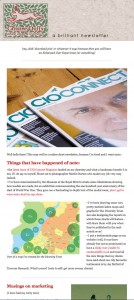6 mistakes not to make when you’re creating your own newsletter
 Newsletters – whether of the almost-dodo-like paper kind or the increasingly-popular email kind – are a great way of keeping in touch with your customers – potential or current. If you’re selling a high-value product or service they give people an opportunity to get to know you and your work before committing to buy, and you can share exclusive offers, and news about exciting new services, with people who are already interested in your stuff.
Newsletters – whether of the almost-dodo-like paper kind or the increasingly-popular email kind – are a great way of keeping in touch with your customers – potential or current. If you’re selling a high-value product or service they give people an opportunity to get to know you and your work before committing to buy, and you can share exclusive offers, and news about exciting new services, with people who are already interested in your stuff.
However, if you make a bad impression you can really put people off your business. Here are six things I’ve seen people do that are pretty much the marketing equivalent of approaching someone you fancy while sporting nothing more than ugg boots, bad breath and a lime-green mankini. Some are design-related and some are more general. Read on!
1) Send people a newsletter without their permission
This is basically spam, and how do we feel about spammers dear boys, girls and those who identify as neither? I make a note of anyone who does this to me and vow never to buy from them. I usually send them a curt email telling them that I have vowed never to buy from them specifically because they have spammed me. Hate hate hate.
Instead, promote your newsletter in email signatures, on your website, on social media, and give people the opportunity to read previous examples before they sign up.
Perhaps offer something in exchange for an email sign up – I offer my 24-page “Guide to creating awesome briefs”.
Also, make it really easy for people to unsubscribe – and tell them you’ve done this before they sign up.
2) Email out the newsletter without using your email client’s “BCC” function
so that the recipient can see everyone else who’s been sent this particular email and, if they’re particularly nefarious, harvest their contact details for their own egregious purposes. What’s really fun is when people “reply-all” to these mails, thus sinking the inboxes of all concerned into a mire of abject clusterfuckery. Ugh. Set up email groups and use the blind-copy address box to avoid this hell – basic stuff, I know, but some people still haven’t figured it out. Or just use MailChimp or Mad Mimi or another newsletter-creation service to avoid the risk of doing this accidentally altogether. Which leads me to…
3) Poor or non-existent HTML skills
If your newsletter design is ropey your clients will most likely think that you are too. If your coding is less fluent than your English then consider using Mad Mimi, MailChimp, or similar services, that will help you create an appropriate style for your audience. In my experience you’re also less likely to end up in people’s junk mail folders by using these, as compared with sending an email directly.
4) Not designed with the reader in mind
By this I actually mean two things:
a) not aimed at the audience
A communication from a purveyor of fine Swiss watches sending out mail with text in bright pink Comic Sans, for example. Either get a designer to help create a theme for you, or research your audience fully and observe how other companies marketing at the same sector produce their stuff. If you sell bridal wear have a look at bridal magazines and design similarly.
b) not designed in a way that makes someone actually want to read the damn thing
I’m thinking great big wodges of text. Reams and reams of times new roman – a glut of words impenetrable enough to embarrass Derrida – which only the most bored or the most desperately procrastinating can be bothered to tackle.
Break your text up:
- headings
- sub headings
- paragraph breaks
- pull-quotes, box-outs
- bullet-pointed lists
- photos
- gifs of kittens in sinks
All of these things draw the reader in, pique their interest and get them, well, reading.
Your writing style is obviously important, too. You need to be entertaining. I attempt to draw my readers in through swearing, poorly-thought-through metaphors and gifs of kittens in sinks but you might want to consider some sort of level of professionalism instead. Personally I save professionalism for the actual work I do – being my rather silly self in communications seems to elicit more positive responses than when I’m attempting to be polite or some such. Whatever works for you and your audience is the thing to do.
5) not sent out at the right frequency
For me, weekly newsletters are too much. It’s a bit like running into someone every other day that you don’t really know but aren’t quite friends with – gets pretty awkward rather quickly. Monthly is good and I’ll generally not unsubscribe from those. I did know of someone who created options for receiving different frequencies of newsletters – there was even a daily one, but you had to pay for that service! Also, creating a newsletter takes quite a bit of time – a few hours for me, generally – so don’t commit yourself to more work than you can realistically handle. Make it clear on your sign-up form how often you intend to infiltrate inboxes so people know what they’re getting into right from the start.
6) Poor choice of content
I get one newsletter that basically just features photos of new lines of vegan shoes and how much they are. Job done – perfect for what I want from them. Other newsletters I love to receive are long, rambling, beautifully-researched, written and illustrated affairs that require jasmine green tea in a bone-china cup and all of the use of my brain (highly recommended SIGN UP FOR NOREEN’S EMAILS THEY ARE SIMPLY DELIGHTFUL). I try to break things up by having:
a) an intro describing what’s in the newsletter
b) a brief paragraph about what I’ve been up to – work I’ve had printed, illustrations I’m half-way through, blog posts I’ve written
c) a longer piece about something design-wise I’ve been chewing over
d) (sometimes) the month’s special offer
e) things that have inspired me that month – art exhibitions, photos of snails etc
f) a little suggested activity to get your creative juices flowing
g) a brief look forward to goings on in the next month
I try to keep things short and sweet but you do what works for you, your audience, and the service you are selling.
Well, I think that’s everything I can think of right now. Most of the time I find it pretty fun writing my newsletter – it’s a wonderful way to talk about what I’m up to and how I can help people’s businesses without being to in-your-face and salesy. Hope this list was of some use – do let me know if you can think of any other bug-bears that you have with newsletters and verily I shall add them!


